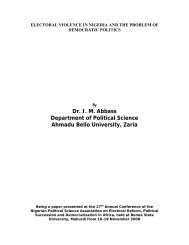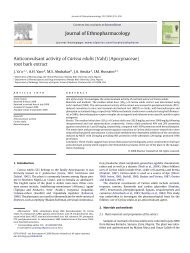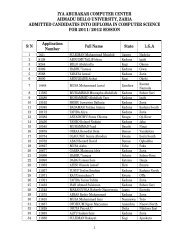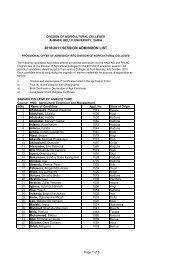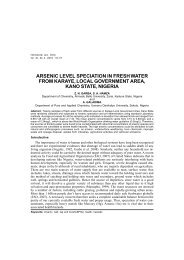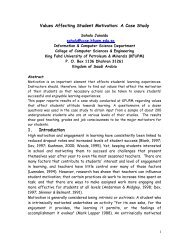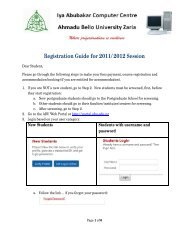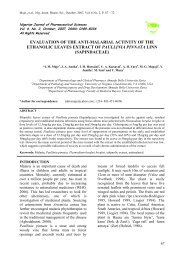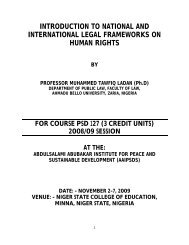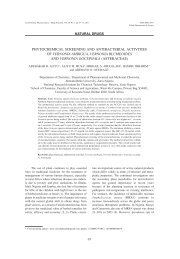Hypotensive Effect of Aqueous Seed Extract of Hibiscus sabdariffa ...
Hypotensive Effect of Aqueous Seed Extract of Hibiscus sabdariffa ...
Hypotensive Effect of Aqueous Seed Extract of Hibiscus sabdariffa ...
Create successful ePaper yourself
Turn your PDF publications into a flip-book with our unique Google optimized e-Paper software.
International Journal <strong>of</strong> Animal Sciences and Veterinary Advances 2(1): 5-8, 2010<br />
ISSN: 2041-2908<br />
© Maxwell Scientific Organization, 2009<br />
Submitted Date: July 21, 2009 Accepted Date: August 19, 2009 Published Date: February 10, 2010<br />
<strong>Hypotensive</strong> <strong>Effect</strong> <strong>of</strong> <strong>Aqueous</strong> <strong>Seed</strong> <strong>Extract</strong> <strong>of</strong> <strong>Hibiscus</strong> <strong>sabdariffa</strong> linn<br />
(Malvaceae) on Normotensive Cat<br />
1 I.G. Bako, 2 M.A. Mabrouk, 3 I.M. Maje, 4 A.A. Buraimoh and 5 M.S. Abubakar<br />
1 Department <strong>of</strong> Human Physiology, Faculty <strong>of</strong> Medicine,<br />
Ahmadu Bello University Zaria, Nigeria<br />
2 Department <strong>of</strong> Medical Physiology, Faculty <strong>of</strong> Medicine, Al- Azhar University Cairo, Egypt<br />
3 Department <strong>of</strong> Pharmacology, Faculty <strong>of</strong> Pharmaceutical Sciences,<br />
Ahmadu Bello University Zaria, Nigeria<br />
4 Department <strong>of</strong> Human Anatomy, Faculty <strong>of</strong> Medicine, Ahmadu Bello University Zaria, Nigeria.<br />
5 Department <strong>of</strong> Pharmacognosy and drug Development, Faculty <strong>of</strong> Pharmaceutical Sciences,<br />
Ahmadu Bello University Zaria, Nigeria<br />
Abstract: The hypotensive effects <strong>of</strong> aqueous seed extract <strong>of</strong> <strong>Hibiscus</strong> <strong>sabdariffa</strong> l. were evaluated in<br />
normotensive cat. The effects <strong>of</strong> the aqueous extract were compared with normal basal rhythm and<br />
Acetylcholine. The drugs and various doses <strong>of</strong> the extracts were injected through a cannula inserted in the<br />
femoral artery. The extract produced a significant reduction in cat blood pressure. The potency <strong>of</strong> the extract<br />
seems to be high because it has activity at 500g/ml. The 1mg/ml <strong>of</strong> the extract exhibited more effective<br />
response, however the standard drug Acetylcholine showed a greater potency than the extract.<br />
Key words: Acetylcholine, blood pressure, <strong>Hibiscus</strong> <strong>sabdariffa</strong> and hypertension<br />
INTRODUCTION<br />
<strong>Hibiscus</strong> <strong>sabdariffa</strong> Linn is a herb belonging to the<br />
malvaceae family. It is grown in all parts <strong>of</strong> the world and<br />
cultivated for its leaf, fleshy calyx, seed or fibre (Dalziel,<br />
1973). <strong>Hibiscus</strong> <strong>sabdariffa</strong> l. is taken as a common local<br />
drink popularly known as zobo in Nigeria. It is a<br />
medicinal herb, used in folk medicine in treatment <strong>of</strong><br />
hypertension (Wang et al., 2000; Odigie et al., 2003).<br />
<strong>Hibiscus</strong> anthocyanin, a group <strong>of</strong> phenolic natural<br />
pigments present in the dried flower <strong>of</strong> <strong>Hibiscus</strong><br />
<strong>sabdariffa</strong> and <strong>Hibiscus</strong> rosasinensis, have been found to<br />
have cardioprotective (Jonadet, 1990; Olatunji et al.,<br />
2005), hypocholesterolemic (Chen et al., 2003), antioxidative<br />
and hepatoprotective (Wang et al., 2000; Amin<br />
and Hamza, 2005) effects in animals.<br />
Delphinidin 3-sambubioside, a <strong>Hibiscus</strong> anthocyanin,<br />
induces apoptosis in human leukemia cells through<br />
oxygen reactive species-mediated mitochondrial pathway<br />
(Ali et al., 2005). Polysaccharides from <strong>Hibiscus</strong><br />
<strong>sabdariffa</strong> flowers stimulate proliferation and<br />
differentiation <strong>of</strong> human keratinocytes (brunold et al.,<br />
2004). <strong>Hibiscus</strong> protocatechuic acid has inhibitory and<br />
inductive effect on tumour promotion in mouse skin and<br />
in human leukemia cells respectively. <strong>Hibiscus</strong> <strong>sabdariffa</strong><br />
has been reported to be antiseptic, aphrodisiac, astringent,<br />
cholagogue, demulcent, digestive, diuretic, emollient,<br />
purgative, refrigerant, sedative, stomachic and tonic<br />
(Morton, 1987; Olalelye, 2007). In Nigeria, a decoction <strong>of</strong><br />
the seeds is given to augment or induce lactation in cases<br />
<strong>of</strong> poor milk production, poor letdown and maternal<br />
mortality (Okasha et al., 2008). However, there is dearth<br />
<strong>of</strong> literature supporting the use <strong>of</strong> seeds. In light <strong>of</strong> this,<br />
the study is designed to evaluate the hypotensive effect <strong>of</strong><br />
<strong>Hibiscus</strong> <strong>sabdariffa</strong> seed extract.<br />
MATERIALS AND METHODS<br />
Chemicals and drugs: All chemicals and drugs used<br />
were <strong>of</strong> analytical grade. Heparin, sodium Thiopentane,<br />
Atropine, Acetylcholine, Adrenaline (Aldrich Chemical<br />
company, Gillingham England) were obtained from<br />
Department <strong>of</strong> pharmacology Ahmadu Bello University<br />
Zaria, Nigeria.<br />
Plant materials: The samples <strong>of</strong> <strong>Hibiscus</strong> <strong>sabdariffa</strong> l.<br />
seed were collected in Gaya Hong Local Government in<br />
Adamawa state <strong>of</strong> Nigeria. The plant was identified in the<br />
Department <strong>of</strong> Biological Sciences, Ahmadu Bello<br />
University, Zaria by Mallam Musa Ibrahim (Taxonomist)<br />
and authenticated voucher samples were deposited in the<br />
Herbarium section (code number 1056).<br />
<strong>Extract</strong> preparation: The <strong>Hibiscus</strong> <strong>sabdariffa</strong> l. seeds<br />
were washed thoroughly, sun dried and ground into<br />
powder. The extraction <strong>of</strong> <strong>Hibiscus</strong> <strong>sabdariffa</strong> l. seed was<br />
done in Department <strong>of</strong> Pharmacognosy and Drug<br />
Development, Ahmadu Bello University Zaria.<br />
Maceration method was used for aqueous extraction. The<br />
mixtures were then shaken for ten hours with mechanical<br />
Corresponding Author: I.G. Bako, Department <strong>of</strong> Human Physiology, Faculty <strong>of</strong> Medicine, Ahmadu Bello University Zaria,<br />
Nigeria, Tell: +2348036982739<br />
5
shaker. The supernatant liquid (extract) was filtered<br />
through a plug <strong>of</strong> cotton or glass wool. The process was<br />
repeated for complete extraction. The extracts were then<br />
poured into evaporating dish to evaporate the solvent in<br />
the extract over the water bath at the temperature <strong>of</strong> 40ºC<br />
- 45ºC (Abdul, 1990).<br />
Int. J. Anim. Sci. Veter. Adv., 2(1): 5-8, 2010<br />
Experimental design: The experiment was an in vivo and<br />
two cats were used. The cat was anesthetized by injecting<br />
Thiopentane sodium via intraperitoneal route. The animal<br />
lost consciousness after 20 minutes <strong>of</strong> administration,<br />
after which it was properly secured to the dissecting table<br />
by using twine to tie its limbs, so as to prevent unwanted<br />
movement <strong>of</strong> the animal during the experiment. The left<br />
femoral vein was exposed and tied with peripheral<br />
ligature. Also, the right carotid artery was exposed and<br />
cannulated for blood pressure measurement. The basal<br />
blood pressure was recorded on a filter paper <strong>of</strong> the<br />
micro-dynamometer after the administration <strong>of</strong> the<br />
heparinized normal saline to prevent blood clothing. The<br />
drugs and extract were administered through the cannula<br />
inserted through the left femoral vein. The speed and<br />
sensitivity <strong>of</strong> the machine were 95mm/minute and 1<br />
respectively. The first set <strong>of</strong> drugs recorded were the<br />
standard drugs (Ach and Adrenaline), followed by graded<br />
dose response for each extract, and the dose which caused<br />
maximum effect was chosen as experimental dose.<br />
Flushing was properly done after every administration <strong>of</strong><br />
extract and drugs till it was brought back to normal.<br />
Phytochemical Analysis: The aqueous seed extract <strong>of</strong><br />
<strong>Hibiscus</strong> <strong>sabdariffa</strong> l. were subjected to preliminary<br />
phytochemical screening, to identify the chemical<br />
constituents. The methods <strong>of</strong> analysis employed were<br />
those described by Brain and Turner (1975).<br />
Acute toxicity study: The lethal dose (LD50) <strong>of</strong> the plant<br />
extract was determined by the method <strong>of</strong> Lorke (1983)<br />
using 13 rats. In the first phase rats were divided into 3<br />
groups <strong>of</strong> 3 rats each and were treated with the aqueous<br />
extract <strong>of</strong> the seed at doses <strong>of</strong> 10, 100 and 1000 mg/kg<br />
body weight intraperitoneal. They were observed for 24<br />
h for signs <strong>of</strong> toxicity. In the second phase 4 rats were<br />
divided into 4 groups <strong>of</strong> 1 rat each and were also treated<br />
with the aqueous extract at doses <strong>of</strong> 1000, 1600, 2900 and<br />
5000 mg/kg bodyweight (i.p). The median lethal dose<br />
(LD50) was calculated using the second phase.<br />
Statistical Analysis: All data are expressed as Mean ±<br />
S.E.M. The data obtained were analyzed using one way<br />
analysis <strong>of</strong> variance (ANOVA) and Turkey-Kramer post<br />
hoc test for multiple comparisons. The (P
Int. J. Anim. Sci. Veter. Adv., 2(1): 5-8, 2010<br />
Table 1: Comparison between Normal Basal Rhythm, Acetylcholine and <strong>Aqueous</strong> <strong>Extract</strong> <strong>of</strong> <strong>Hibiscus</strong> <strong>sabdariffa</strong> l.<br />
Blood pressure [mm Hg] Basal Rhythm Acetyl- Choline <strong>Aqueous</strong> extract <strong>of</strong> <strong>Hibiscus</strong> <strong>sabdariffa</strong> linn<br />
---------------------------------------------------------------------------------<br />
0.5 mg/ml 1.0 mg/ml 5.0 mg/ml<br />
Systolic pressure 48.0±1.4 39.0±3.8 S 35.0±0.4 S 35.5±2.4 S 44.0±3.1 S<br />
Diastolic pressure 32.5±1.6 16.3±3.4 S 26.5±0.5 S 26.5±0.7 S 26.5±0.8 S<br />
Pulse pressure 15.5±2.5 19.5±0.9 S 8.5±0.6 S 6.8±10 S 17.8±5.6 NS<br />
MAB pressure 36.5±2.4 35.3±1.1 NS 29.3±0.5 S 31.3±0.6 S 33.8±1.1 S<br />
Table 2: Comparison between Acetylcholine and aqueous extract <strong>of</strong> <strong>Hibiscus</strong> <strong>sabdariffa</strong> l<br />
Blood pressure [mm Hg] Acetylcholine <strong>Aqueous</strong> extract <strong>of</strong> <strong>Hibiscus</strong> <strong>sabdariffa</strong> linn<br />
---------------------------------------------------------------------------------<br />
0.5 mg/ml 1.0 mg/ml 5.0 mg/ml<br />
Systolic pressure 39.0±3.8 S 35.0±0.4 S 35.5±2.4 S 44.0±3.1 S<br />
Diastolic pressure 16.3±3.4 S 26.5±0.5 S 26.5±0.7 S 26.5±0.8 S<br />
Pulse pressure 19.5±0.9 S 8.5±0.6 S 6.8±10 S 17.8±5.6 NS<br />
MAB pressure 35.3±1.1 NS 29.3±0.5 S 31.3±0.6 S 33.8±1.1 S<br />
Table 3: Drug Antagonistic Studies<br />
Drug + <strong>Aqueous</strong> <strong>Extract</strong> 0.2 ml Atropine [100g/ml] 0.1ml Ach [10g/ml] +<br />
+ 0.4ml Aq. extract [1mg/ml] 0.4ml aq. <strong>Extract</strong> [1mg/ml]<br />
---------------------------------------------------------- -------------------------------------------------------------<br />
Blood pressure parameters [mm Hg] Atropine Atropine+aq. ext % change Ach Ach + aq. Ext % change<br />
Systolic pressure 39 40 2.5 40 35 12.5<br />
Diastolic pressure 30 30 0.0 30 27 10.0<br />
Pulse pressure 9 10 2.5 10 8 20.0<br />
MAB pressure 33 33.3 1.0 33.3 29.5 11.5<br />
Fig. 3: Tracing <strong>of</strong> 5mg/ml <strong>of</strong> aqueous seed extract <strong>of</strong> <strong>Hibiscus</strong><br />
<strong>sabdariffa</strong> l. with volumes <strong>of</strong> 0.8 and 1.6mls.<br />
Fig. 4: Tracing <strong>of</strong> drug antagonist studies <strong>of</strong> 0.4ml <strong>of</strong> 5mg/ml<br />
aqueous seed extract <strong>of</strong> <strong>Hibiscus</strong> <strong>sabdariffa</strong> l. blocked<br />
by 0.1ml <strong>of</strong> 100g/ml <strong>of</strong> Atropine.<br />
5.0mg/ml) <strong>of</strong> seed extract decreased significantly<br />
(P0.05) when compare to normal basal rhythm.<br />
The tracings <strong>of</strong> 500g/ml in Fig. 1, 1mg/ml in Fig. 2 and<br />
5mg/ml in Fig. 3 showed hypotensive effect <strong>Hibiscus</strong><br />
<strong>sabdariffa</strong> l.<br />
The standard drug Acetylcholine also when compared<br />
to the normal basal rhythm, the blood pressure (systolic<br />
and diastolic), pulse pressure and mean arterial pressure<br />
in all the doses <strong>of</strong> Acetylcholine decreased significantly<br />
(P
Int. J. Anim. Sci. Veter. Adv., 2(1): 5-8, 2010<br />
significant statistical difference (P


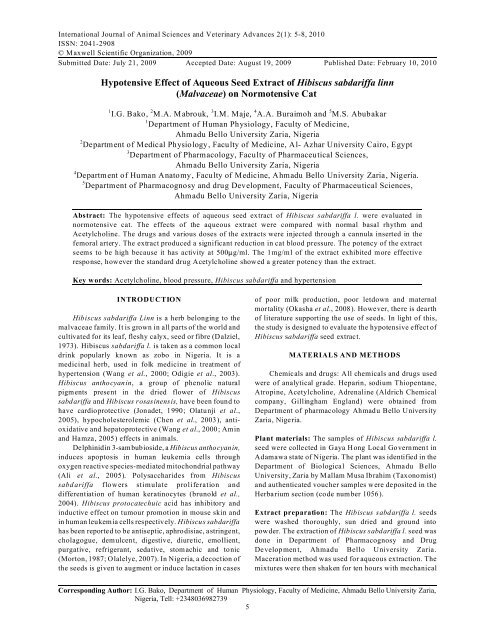
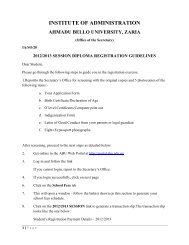
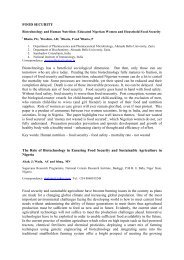
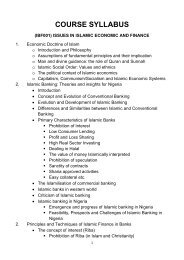
![Full Paper [PDF]](https://img.yumpu.com/49740055/1/184x260/full-paper-pdf.jpg?quality=85)
